
|  |

|  |
 e-mail: khokar1960@gmail.com Men to the fore! Photos courtesy: Ganesa Natyalaya March 24, 2024 Rama Vaidyanathan, that dynamic all in one - dancer, teacher, choreographer, organiser, mother and mentor - has worked very, very hard to sustain a career in dance with family responsibilities, running a school, career and more. Today, Rama Vaidyanathan has also left a mark as the best Natya Kala Conference host with most outreach, acclaim and applause. Her students are now a legion, spread all over the world. Rama today ranks as numero uno in her generation of Bharatanatyam artistes. 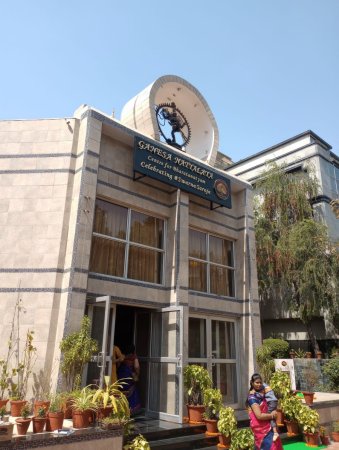 Ganesa Natyalaya (Photo: Ashish Khokar) So, when in the Swarna Saroja year - marked to peg 50 years of her saas-guru creation the Ganesa Natyalaya - she platformed 25 male dancers in one day, she created a new record in excellence, entertainment and engagement with art. Male dancers have had an unusual history. Most first generation gurus, nattuvanars or gharana dancers were men. Even forms like Kuchipudi, Yakshagana, Sattriya and of course Kathakali had only male dancers. Then slowly the city-smart and college educated girls of Mumbai, Chennai, Kolkata started taking to these and other classical forms. A trend started that slowly brought prakritis to the forefront and purush started getting relegated to the background. There were of course the couple dancers like Uday Shankar - Amala, US Krishna Rao - Chandrabagha Devi, Gopinath - Thankamani and Nataraj - Shakuntala. Next generation copied that idea of couple dancing or were inspired by above names and so we had the Dhananjayans, the Reddys, Singhajit Singh - Charu Sija Mathur, Thankamani - Govindan Kutty, Jayarama Rao -Vanashree Rao and more in many forms. Solo male dancing got marginalised in the 90s and relegated to dancing in the group or in some production where women did not have natural moustaches! By 2000 the situation was pretty acute. Even all male forms like Kuchipudi had more women than men practitioners. Kathakali, the all-male bastion, slowly had women join in. Even Kerala Kalamandalam started teaching girls. Ditto Sattriya. The original celibate monks were replaced by dancing damsels, with national cultural agencies giving undue recognition to this new trend. By the turn of this century, some concerned do-gooders in dance field took upon themselves to help reverse the tide. Anita Ratnam mounted many initiatives for just male dancers, like her mega production Purush in 1995 and at Natya Darshan 2013 as convenor. Yours truly started Purush festival and tours abroad from 2010-to date and even instituted attenDance award named after the pioneer of solo male dancing, Ram Gopal, to encourage male dancers. 10 have been awarded up till now (complete list on attendance-india.com) of whom many are much in demand and even awarded by other national bodies and agencies. Solo is the operative word. Otherwise men have been dancing and will continue to. But as soloists how many have won acclaim or accolades? To every Birju Maharaj, there are hundreds unknown and unsung. Rama Vaidyanathan's initiative in Delhi can be seen as a solid step in that direction which helps bring many deserving male solo talents to the fore, on one single platform. It also helps platform her students from outside Delhi, in Delhi. Lots of boys from Bengal in this festival surprised one. There's a reason for it as senior Odissi dancer-choreographer Sharmila Biswas privately explained. There is no real eco system in Bengal for Bharatanatyam to flourish as few gurus or musicians are there for support. Earlier, teachers were far and few and just managed to establish the form in a land that has too much culture but no classical form of its own. Rama Vaidyanathan also included all forms, which was good to see for audiences. Delhites came in droves to the Lalitha Kala Mandap chamber theatre, named after late guru Saroja Vaidyanathan's guru Lalitha Sastry but the head of that bani is not Thanjavur Muthukumaran Pillai as stated on photo frame in the hall's back wall of fame, but Tillai, Chidambaram, Kattumannarkoil. As so many Natarajas were going to dance, the day began with an old-fashioned power point presentation by seasoned arts and crafts activist, writer, story teller (her preferred description) V.R. Devika. Mysore born settled in Madras, she has been a jack of many trades in last forty plus years and has been engaged with several field projects for INTACH, Crafts Council of Chennai, the Dakshinachitra museum and promotion of Therukoothu. She gave an interesting link to astronomy and astrology with some fascinating facts and tales. With a brief inaugural introduction by yours truly to the purpose of projecting Purush dancers, the whole day focus started with four Hardy boys! Himanshu Srivastava, Samsur Rehman, Amrit Sinha and Vinay Tiwari, each one bringing his artistry to the stage. 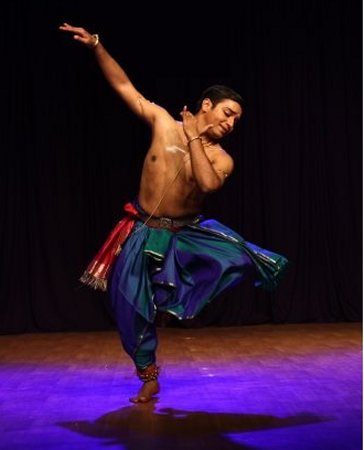 Himanshu Srivastava Himanshu Srivastava, the upcoming male student of gurus Saroja and Rama Vaidyanathan started the day-long, non-stop festival with what else, but a Ganapati Vandana. Here's a mature artiste, understated and deep. Even in ninda stuti, his cameos provided humour and affectionate regard for the patra. His hastas are well etched and despite exaggerated Kathakali eyes at times, his abhinaya is evolved and dignified. Can he do nritta items, as well? Could not be really established. Each dancer was given 20 minutes and most should've used the time efficiently to bring both aspects to fore. If first dancer of the festival was all abhinaya intensive, the last one with unplanned items, music cut at random, made for a poor end to the handsome day-long offering. Next were foursome lads from Manipur, all students of Shyam Singh. Dhol, mardala, kartal and pakhawaj, they did basic features as the music was recorded anyway. That Delhi youngsters hoot and scream in pretentious and predictable delight shows this generation of millennials has not seen much or think they are at a college function. The next Kathak pair was fun like a Laurel and Hardy pair, comical in their Kathak and not a care if the third eye (trilochan) could pop out of their abundant floppy hair! Which one was who (named Ashish and Bhava Gangani) was never clearly announced and they did not clear their names either. In Adi Shankaracharya's Panchakshara stotram Nagendraharaya, not once did I spot any snake in their hastas making it safe for audience not to worry much. 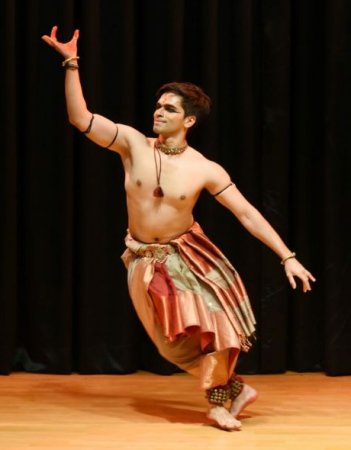 Shobhit Ramesh Shobhit Ramesh looked like a marble or ivory statue next. It is only when he moved that one realised he was not a statue! He was confident of his work the way he just came and stood on stage, even before the music had started. And what movement! Taut lines, clear delivery and as items progressed, he just opened up his abhinaya prowess. His was the most well thought out use of time allotted and neatest presentation. He was the hidden gem up till then. A student of Parshwanath Upadhye, he did his teacher proud. He has to loosen up a bit and smile, as it is the best abhushan. Varun Khanna next of Chandigarh is a happy looking Punj from the land of five rivers, now divided into three states and two countries. Punjabis claim their culture is agriculture so when this smiling lad from its capital Chandigarh performs, one can clench one's teeth because he is a dentist too! In BN dance, however, he has a faulty araimandi posture that should have been corrected long ago - stooping forward because the bent knees don't open up sideways but flop midway. For big city audiences, he needs to shape up. As Hanuman, he did full justice even if the soundtrack was Tamil filmy music. When asked later what it was, he had no clue. Dancers ought to know their materials well. One can't get on stage and not know who composed the song or sang it even. Varun needs to get a proper foundation before taking off, professionally. Akshar Tekchandani has something that's an inborn gift - stage presence. Looking at him for a moment one thought one was seeing late star kathakaar Pt.Durgalal - same flourish and flair. He danced the Shiva Stuti in raga Sankara with involvement. He needs to have proper finish though so his good looks not come in the way of dance. His hastas are clean though Kathak male dancers need to do something about their aharya on the whole; flip flop hair, shiny costumes shows aesthetics or lack of it. On the whole, he showed promise. 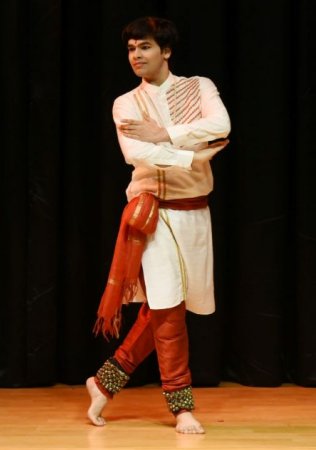 Akshar Tekchandani 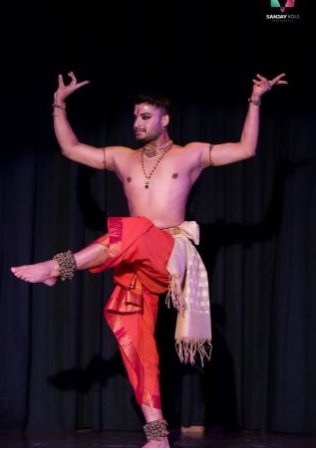 Washim Raja Gopalakrishna Bharati's Eppo Varuvaro was handled well by Nilay Mandal. He went through the paces with ease. Washim Raja next in Mahadeva Shiva Shambho was a perfect combo of lasya and tandava aspects of the deity. Here is a talent that makes one sit and watch. That's called commanding the stage. He reminds one of the star Kuchipudi dancer of the seventies, Kamadev. Washim is trained by guru Vanashree Rao and one can see the depth of training and absorption. Here is a dancer to watch because each aspect is in perfect proportion and his delivery is impeccable. His crew cut hair shows he doesn't depend on extremities for props to his dance which is strong yet supple. He is a star material. One has to pause and think why most male dancers choose only Shiva or Krishna as fodder. Why not Arjun or Karna? Or some dark, unusual character like Mahishasur or Duryodhana? Why not Buddha or Yudhishtra? Then too, are male dancers happy with few performances in a year or will leave everything else for dance? Is it a dance of indulgence or deep interest? When does training stop? Learn few items and then dance here and there and with social media and fake followers, feel good. The hooting in hall by own friends and fans also help boost ego. So far so good. Then what? In the real world and market, how do they go further? If they don't need to then no issue but if any one in these 25 wish to become national or even a professional then they need to really sweat it out, work hard and be at it to the exclusion of all else. Dance makes for a very tough master or mistress! Can't go with anything else in life, really. All top dancers of the country, I'm talking of soloists, have had to sacrifice a lot to reach where they have. There are no short cuts. Out of 25 seen, one could discern only five with fire in their belly. Next 5 - Washim, Shobhit, Tekchandani, Pritam and Vishal - have potential to go far, other things being equal. The last 5 - Himanshu, Gaurav Bhatti, Krishnendu Saha, Nilava Sen and Anand CS - should work harder to become professionals. Himanshu has been spoken for in the opening paras. Gaurav has tayari and tehzeeb but needs to guard against vanity. He was the best turned out in costume and aesthetics. After all, an Aditi Mangaldas product 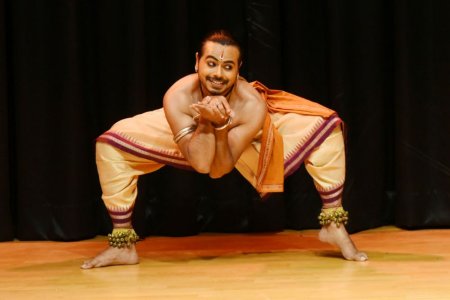 Krishnendu Saha 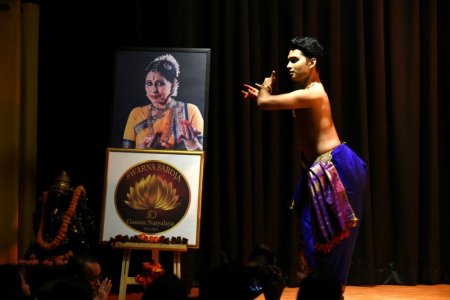 Nilava Sen Professionalism is a state of being and lies in details. Krishnendu Saha smiles even in vaman and kacchap avatars, what for? A good dancer and foundation he has but he is prone to too much lokadharmi quality in depiction. For someone just starting to make a mark in professional dance world, living in a total offbeat place like Udaipur - far from any classical links to Odissi - at this stage of his nascent career might be a loss to his professional career and outreach. Dance calls for a lot of sacrifice. It is not easy to master and makes for a very difficult mistress! Nilava Sen not only wore a nilo as in blue costume but danced blues! Good overall finish. His face and dance is contained. There's a sense of inner peace and satisfaction. And Anand's dance has ananda! Sheer joy, even if jumpy in parts but that's youthful energy. He was like a rubber band on stage. He was the surprise of the day. This talent needs the support India can give. 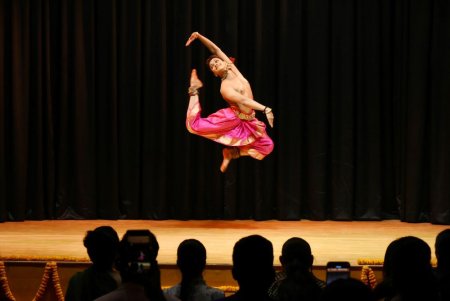 Anand CS Five were unusual: Pankoj Singha Roy in Kalidas' Kumarasambhava was peaceful. Vinay Tiwari was short and sweet, no clutter. Santanu Roy with his dreamy eyes looked like walking or dancing in sleep or on auto pilot. Other two Samsur Rehman and Amrit Sinha held their own. Shubham Acharya in Seraikella Chhau could have done more justice to his inheritance and lineage. Sahil Suresh in Kathakali failed to impress despite rich costume. Then there was BN with the oldest proponent on stage that day (Nandanaar, who failed to lift from the ordinary. There was abundant bhakti and shakti in his rendition but where was any nritya, technique for which he's so known?) and Vishal Krishna's Kathak in the end (so much energy, to what end when there was no plan, no approach). Manipuri by Shyam Singh’s students was basic and novelty value at best. 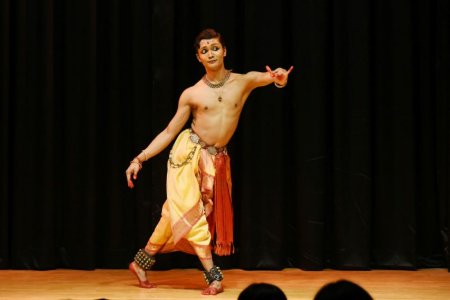 Pritam Das Pritam Das' dancing was like a ball of fire that took one to Brihadeeshwara in Tanjore. Just like elephants pulled stones on wooden shafts those days in the tenth century effortlessly and granite isn't even indigenous to the place, likewise Pritam carries the weight of Bharatanatyam on his slim frame, effortlessly. Rather an overdose of lokadharmi abhinaya, he needs to watch out for missing the woods for the trees. In between, one wondered how did the audience or the girls in the audience, who also dance, feel watching male dancers on stage? Is it any different? Did they feel they watched a privileged lot of "endangered species" or as a novelty item that's no real competition because there are so few? Is there any data with SNA on how many male dancers are there in the country? Is there any scheme to support them? Do they need support or in this jungle rule it is the survival of the fittest? Also, in this lot of 25 male dancers not one was a modern or contemporary dancer. That's a huge constituency these days. Maybe, next time. All had a good time dancing. How many are real artistes and not mere 'item' boys, time will tell. The idea was good and kudos to Rama Vaidyanathan and team to host so many, giving many outstation students of hers and others a chance to dance in the capital city. There was evident camaraderie all around. That stars and seniors like Aditi Mangaldas, Guru Geetanjali Lal, gurus Jayarama Rao and Vanashree and Jayaprabha Menon were in attendance showed Delhi cares. Dakshina, dancer-daughter of Rama conducted pithily while Sannidhi played mridangam in the beginning itself, ably. Guru Saroja Vaidyanathan's smiling faced son Kamesh stood ten hours non-stop in service of dance to do lights and sound. Nataraja on top of the building and many in the hall, looked pleased. When father is happy, son Ganesa (Natyalaya) beamed too. 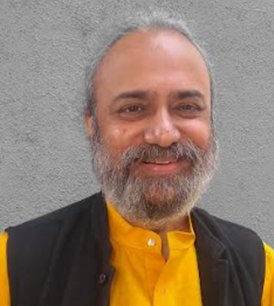 Critic, connoisseur, historian, author, artivist, archivist, administrator and more - editor, columnist and mentor Ashish Khokar remains true to his muse. More on attendance-india.com Responses * Respected Sir, Thank you for your kind words of encouragement. They have been highly motivating to look within and work harder ahead. Your presence at the festival, your informative speech in the beginning and the end, and this detailed review, are all extremely warm. - Akshar Tekchandani (April 12, 2024) * Here is one critic who speaks out his mind with elan. This is how healthy criticism should be. Unbiased and impressive. - Rahul Acharya (March 25, 2024) * In your impeccable style, a beautiful review. This festival is truly a space for male dancers. Kudos to Ramaji. - Harikrishna Kalyanasundaram (March 25, 2024) * Very well coverd of the entire day, with so much simplicity & understanding, with suggestions too for each artist. Ashish ji always writes from his heart. It was like reliving the moments of the entire day as I attended the festival. Congratulations to Ganesa Natyalaya for organizing such a significant festival for male dancers. - Abdul Khalid (March 24, 2024). Post your comments Please provide your name and email id when you use the Anonymous/blog profile to post a comment. All appropriate comments posted with name and email id in the blog will also be featured in the site. |